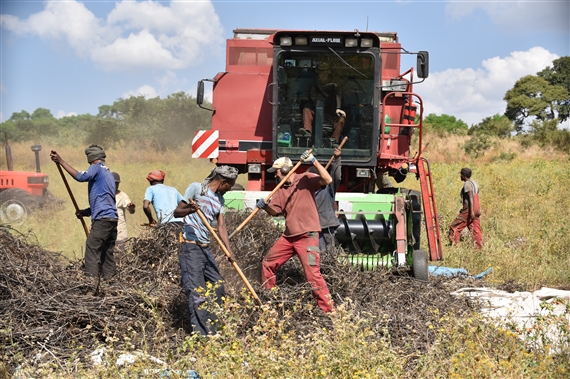 By Sebastian Hagenbuch
By Sebastian Hagenbuch
You want hard facts and facts about Ethiopian agriculture instead of talk about land, people and roads? That would have our blogger Sebastian Hagenbuch sometimes like. He tries it anyway.
So far, I have not really quenched the thirst of inquisitive Swiss farmers for handfesterem, correct. How so? I do not understand myself very well, why here what is done. And I only have a little insight into a small region of a country that is 27 times larger than Switzerland and by no means homogeneous. But nevertheless, let’s try it:
Farming is often done on small areas and without mechanization: plowing is done with the ox, sown by hand, sometimes back splashes are used against the weeds. The cereal “Tef” is often grown as the basis of the national dish “Injeera”, mowed by hand with sickles and then piled up in heaps. To thresh, the grain is spread on the ground and trampled by oxen. Isolated are small two-stroke engines in use, which drive a stationary threshing machine. Here people can bring their crops with their donkeys. After the Tef harvest (October) follows the dry season: Those who are early enough, can still grow chickpeas, which can still grow with the existing residual moisture in the soil.
Corn and sorghum are also common. The corn is harvested by hand and left bundled in oversized sheaves on the field until it is completely dry. Also important is the cultivation of “Berbere” (a kind of chili peppers). The pods are harvested by hand and laid out to dry on the ground and guarded there until everything is bagged and sold. Speaking of sacks: The standard unit is 100 kg bags of Tef or corn. 2 men (each about 50 kg heavy) hoist a sack on the back of a third party, who runs with the bag to the truck and pushes up in high. Also coffee, mangos, citrus fruits, bananas and papayas are grown, as well as other fruits, whose name I do not know. The limiting factor is usually the water during the dry season, which lasts from November to April.
In the Nono project, where I work, thanks to development aid a lush mechanization is present: beans and Tef be forked from swath or from the heap in the Case thresher (driving the fields due to massive bumps often impossible), the corn can in the Usually be threshed standing. For the handling of machines the project staff are often still dependent on European help.
In the field of animal husbandry some Zebu and flocks of sheep are to be seen, also goats are kept and many donkeys and rarely horses are used as pack animals. Here, the zebus spend the night in the barn and are driven by the shepherds to the fields during the day and brought to drinking troughs. Some cows are milked: a calf is left to the herd in the barn and runs there followed by the milker to his mother. An assistant keeps the calf in front of the cow, the milker milks the cow by hand – about 1-2 liters per day are in it, the rest (not much …) is then for the calf. The milk is boiled and drunk or processed into cream cheese and butter (popular is rancid butter, also used for hair care).
The extraction of food is a difficult, labor-intensive way with challenges that are unknown to us: The corn fields must also be guarded at night: Monkeys lurking outside the grounds for their chance. If the sheep are without a shepherd, a lamb disappears into the belly of a python snake. And if the crop is not provided with a guard, the night or possibly one bag of food disappears without a trace …
What should a Swiss farmer do exactly here? There are quite a few days when I asked myself that too. My field of activity is also very diverse: Laying and repairing water pipes, road maintenance, repairs in the workshop (especially generators …), cleanup, propagation of sweet potato seed, delivery of the kitchen with otherwise decaying fruits, corn, bean and tefernte, maintenance The tractors, driving instructors, adjustment of machinery and above all assistance in the daily necessary improvisation due to more or less unpredictable.